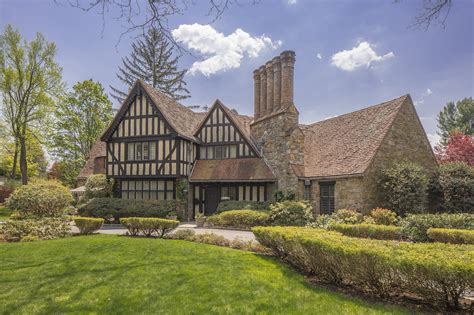The allure of Tudor Revival homes has captivated homeowners and architects alike for centuries. This architectural style, which emerged in the United States in the late 19th century, is a nostalgic nod to the traditional English Tudor homes of the 16th century. Characterized by their distinctive half-timbered facades, steeply pitched roofs, and ornate decorative elements, Tudor Revival homes have become a staple of American suburban landscapes.
One of the defining features of Tudor Revival architecture is its use of half-timbering, a technique where wooden beams are exposed on the exterior of the building, often in a decorative pattern. This style of construction was popularized during the Tudor period in England, where it was used to create sturdy and durable homes. In the United States, half-timbering was often used as a decorative element, rather than a structural one, and was typically combined with other materials such as brick, stone, or stucco.
Tudor Revival homes often feature steeply pitched roofs, which were designed to shed snow and protect the home from the elements. These roofs are typically covered in slate or clay tiles, which add to the home’s rustic charm. The roofs are also often adorned with decorative elements such as chimneys, finials, and cresting, which add to the home’s visual appeal.
Another distinctive feature of Tudor Revival homes is their use of ornate decorative elements, such as carved wood, intricate moldings, and decorative metalwork. These elements are often used to create a sense of grandeur and luxury, and can be found in everything from the home’s front door to its fireplace surrounds. In many cases, these decorative elements are inspired by traditional English designs, and are used to create a sense of historic authenticity.
Despite their historic roots, Tudor Revival homes are often designed with modern comforts and conveniences in mind. Many of these homes feature spacious floor plans, complete with large kitchens, formal dining rooms, and comfortable living areas. They may also include modern amenities such as central air conditioning, high-efficiency appliances, and advanced home security systems.
For those looking to purchase or build a Tudor Revival home, there are several factors to consider. Firstly, it’s essential to work with an architect or designer who is familiar with the style and can create a design that is both authentic and functional. It’s also important to consider the materials and construction methods used, as these can greatly impact the home’s durability and maintenance requirements.
In terms of maintenance, Tudor Revival homes can be more demanding than other styles of homes. The half-timbering and decorative elements can be prone to rot and damage, and the steeply pitched roofs can be challenging to repair. However, with regular maintenance and upkeep, a Tudor Revival home can be a beautiful and durable investment for years to come.
For those who are looking to add a touch of Tudor Revival style to their existing home, there are several ways to do so. One option is to add half-timbering or other decorative elements to the exterior of the home. This can be done using a variety of materials, including wood, vinyl, or fiber cement. Another option is to incorporate Tudor Revival-style decorative elements, such as carved wood or intricate moldings, into the home’s interior design.
In conclusion, Tudor Revival homes offer a unique blend of historic charm and modern comforts. With their distinctive half-timbered facades, steeply pitched roofs, and ornate decorative elements, these homes are a staple of American suburban landscapes. Whether you’re looking to build, purchase, or simply add a touch of Tudor Revival style to your existing home, there are several factors to consider. By working with an experienced architect or designer and considering the materials, construction methods, and maintenance requirements, homeowners can create a beautiful and durable Tudor Revival home that will stand the test of time.
What are the key features of a Tudor Revival home?
+Tudor Revival homes are characterized by their distinctive half-timbered facades, steeply pitched roofs, and ornate decorative elements. They often feature exposed wooden beams, decorative metalwork, and intricate moldings.
What are the benefits of owning a Tudor Revival home?
+Tudor Revival homes offer a unique blend of historic charm and modern comforts. They are often highly sought after for their aesthetic appeal and can increase in value over time. Additionally, many Tudor Revival homes are built with high-quality materials and construction methods, making them durable and long-lasting.
How can I add a touch of Tudor Revival style to my existing home?
+There are several ways to add a touch of Tudor Revival style to your existing home. One option is to add half-timbering or other decorative elements to the exterior of the home. You can also incorporate Tudor Revival-style decorative elements, such as carved wood or intricate moldings, into the home’s interior design.



